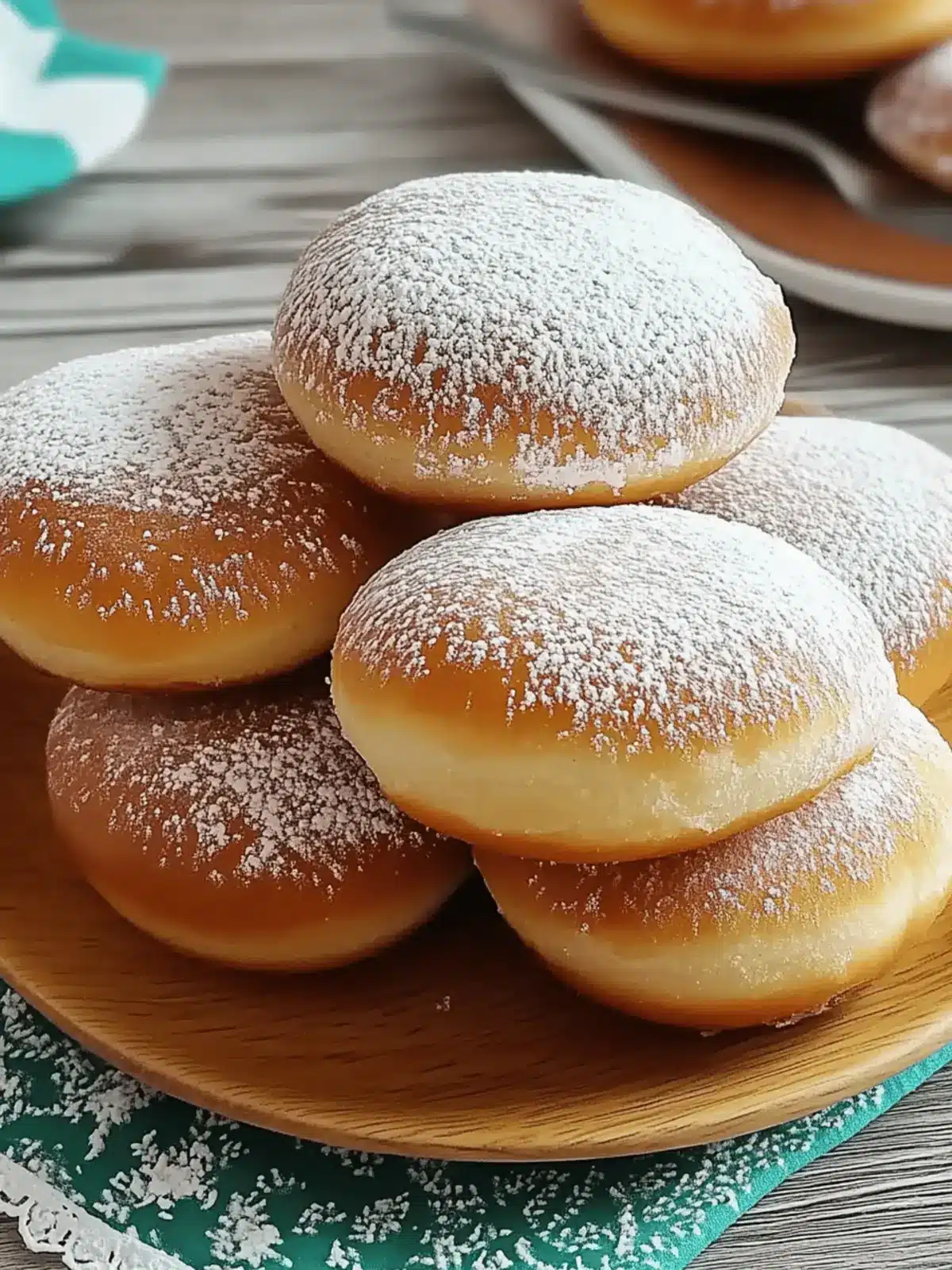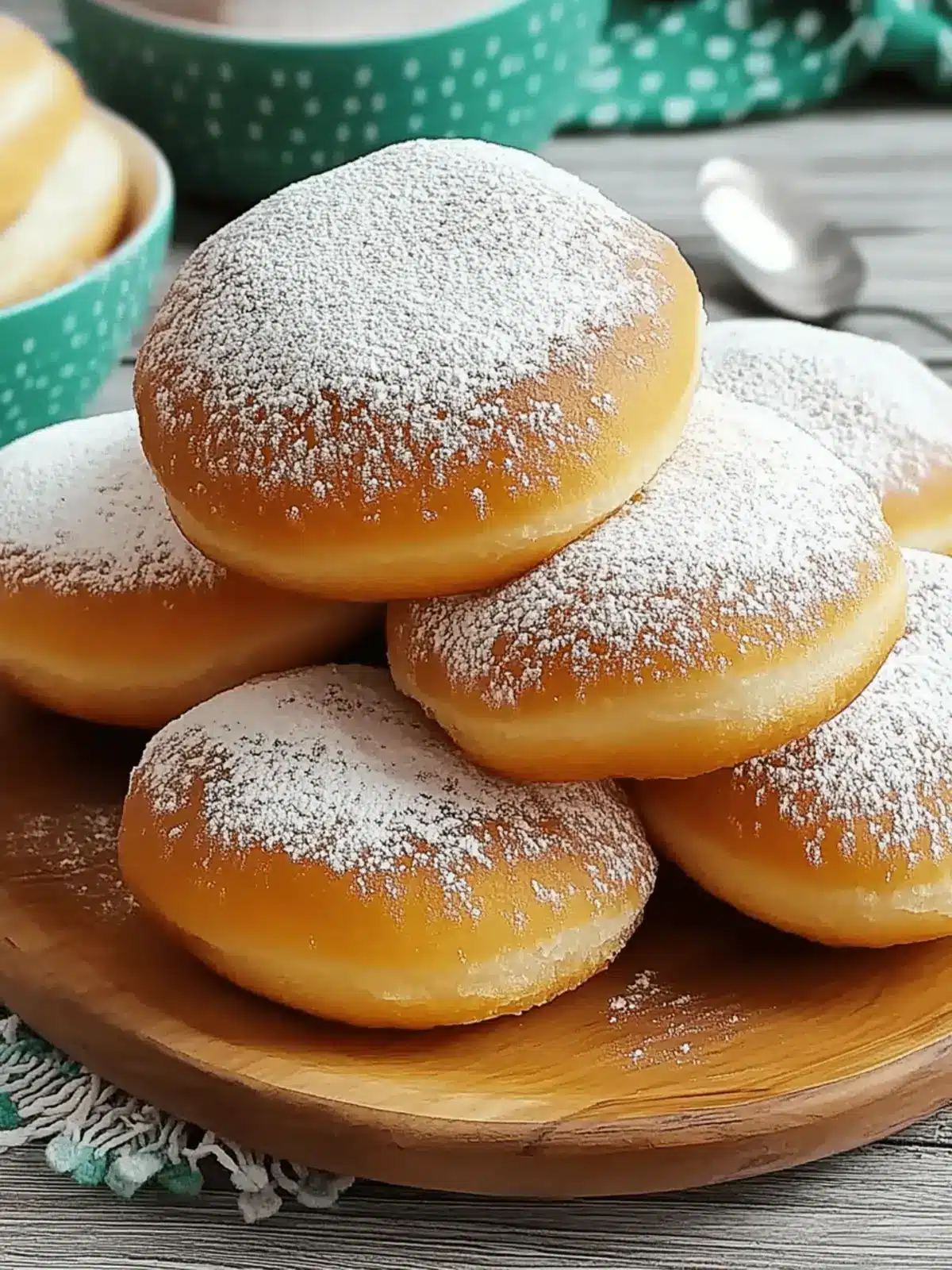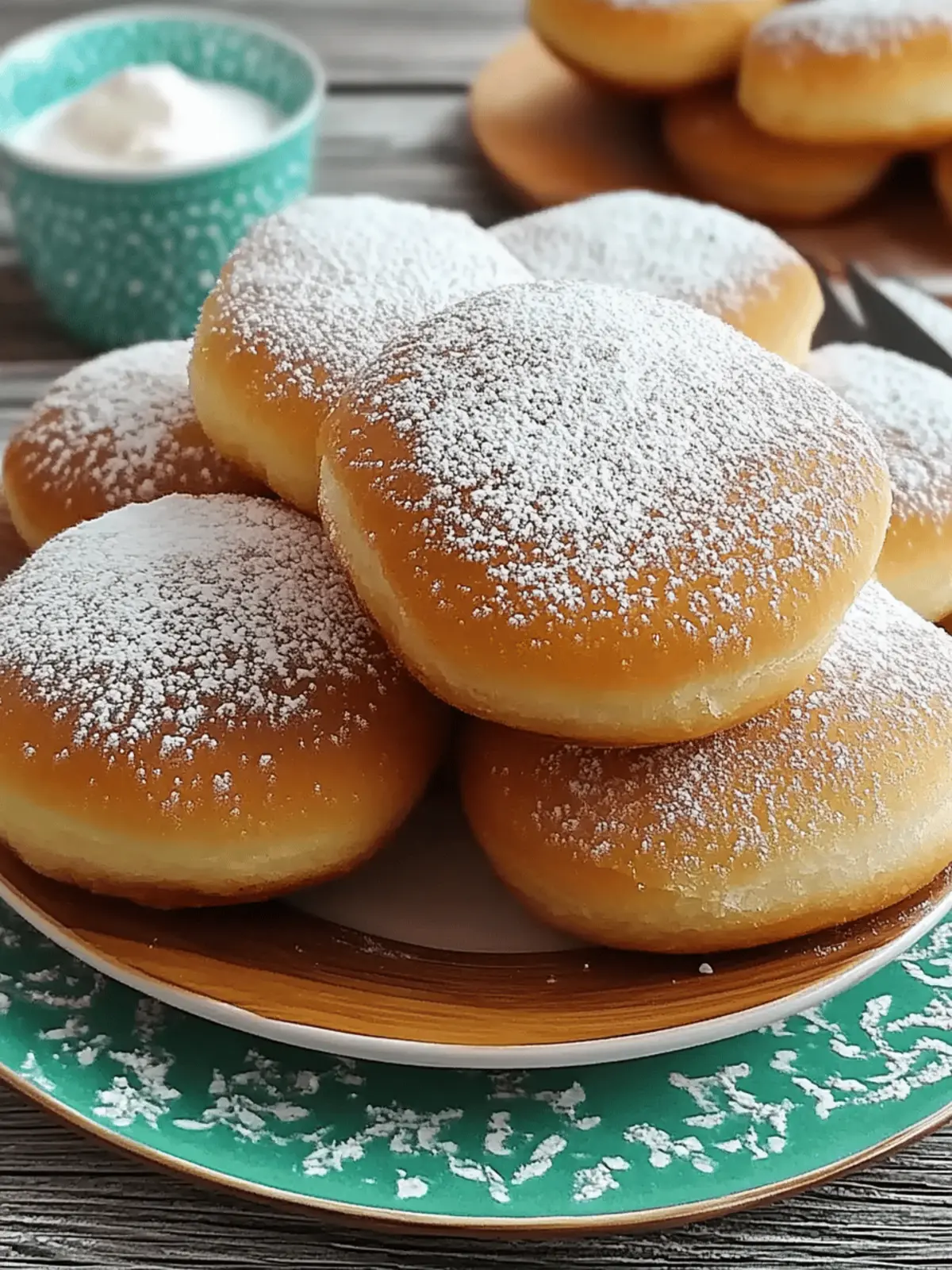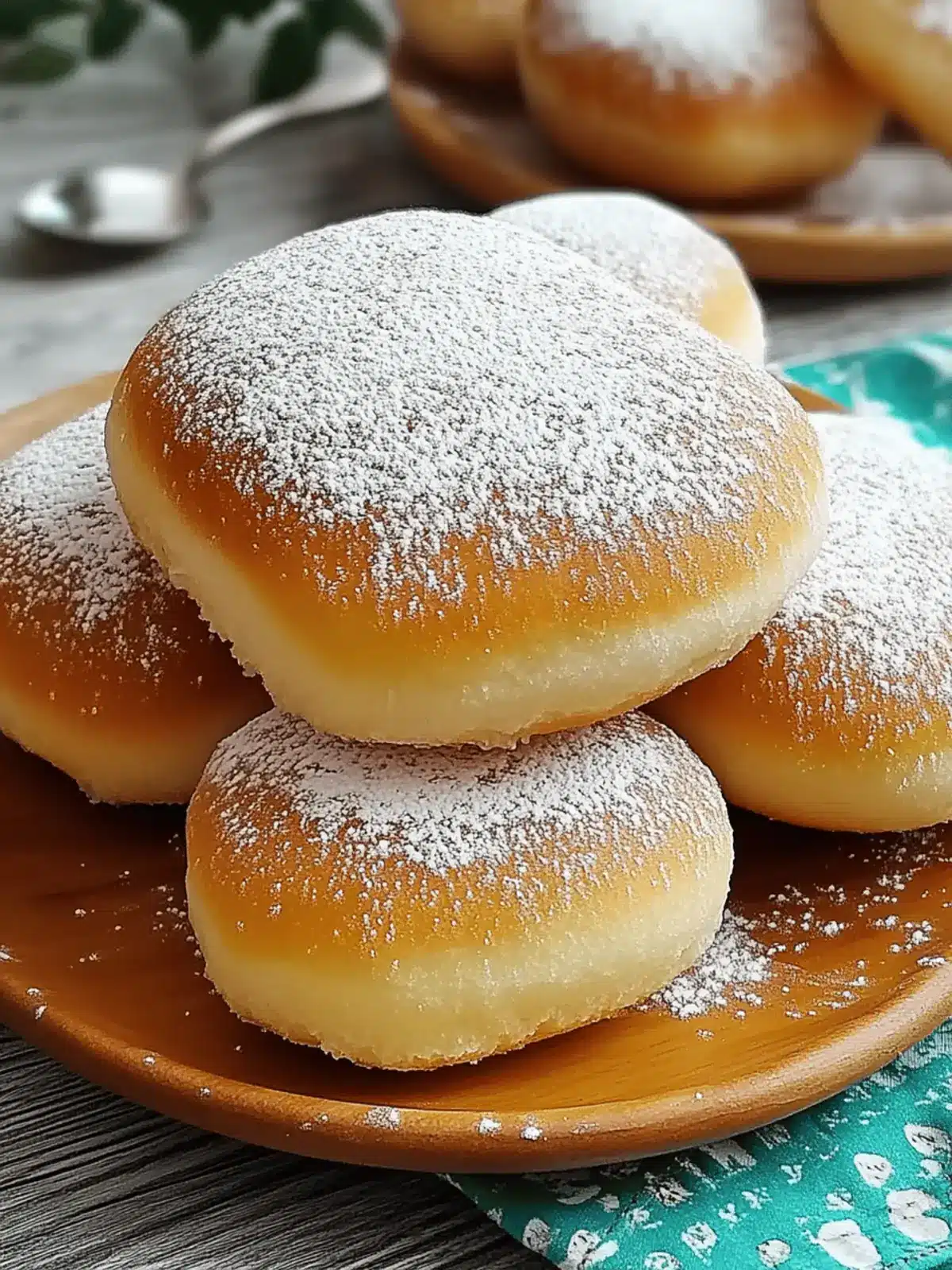When the weekend rolls around, there’s nothing quite like the joy of transforming my kitchen into a cozy café, and what better way to do that than with a batch of homemade beignets? These light and fluffy French pastries are as delightful to make as they are to eat, emanating a warm, inviting aroma that fills the air like a sweet hug. With a simple five-step process, these little clouds of joy can elevate your breakfast or brunch to something straight out of New Orleans.
I was inspired to create this beignet recipe on a crisp morning when a craving for something indulgent struck. As I whisked the dough and watched it rise, I imagined all the possibilities – from classic powdered sugar to rich chocolate glazes and fruit fillings. Whether you’re a seasoned chef or just starting your culinary journey, this easy beignet recipe is sure to impress your family and friends, turning a regular brunch into a memorable occasion filled with laughter and deliciousness. Let’s dive in!
Why is this Beignet Recipe a Must-Try?
Simplicity at its finest: With just five easy steps, you’ll be whipping up these delightful pastries in no time.
Irresistible flavor: The soft, airy texture combined with a silky powdered sugar topping makes each bite a true delight.
Versatile options: Experiment with fillings and glazes to create your perfect beignet experience. Whether you prefer a classic or a modern twist, this recipe delivers!
Crowd-pleaser: Ideal for brunch gatherings, your friends and family will be buzzing with compliments, making it a dish to remember.
Feel-good nostalgia: Transport yourself to a French café every time you indulge in these buttery treats—perfect for those weekends when comfort food is a must.
Elevate your brunch game with these flavorful beignets, and for an even deeper dive into breakfast pastries, check out our guide on the art of homemade croissants.
Beignet Recipe Ingredients
For the Dough
• Warm Water – Activates yeast; use warm, not hot water for optimal yeast performance.
• Yeast – Provides rise and structure; ensure it’s fresh and foamy during activation.
• Sugar – Adds sweetness and aids yeast activation; can be replaced with alternative sweeteners.
• Egg – Adds richness and moisture; feel free to use egg substitutes for a vegan version.
• Milk – Contributes to a tender texture; any dairy or non-dairy milk can work.
• Salt – Enhances flavor; essential for balancing the taste.
• Flour – Forms the bulk of the dough; all-purpose flour can be substituted with a gluten-free blend.
• Butter – Imparts flavor and richness; ensure it’s softened, and for dairy-free options, use vegan butter.
For Frying
• Oil – Essential for frying; choose a neutral oil like canola or vegetable oil for best results.
For Topping
• Powdered Sugar – Dust generously on beignets while they’re warm to ensure it sticks deliciously.
This beignet recipe will guide you on your journey to creating these delightful, fluffy pastries that charm any breakfast table!
How to Make Beignets
-
Combine Ingredients: In a large bowl, whisk together warm water, yeast, and sugar. Allow this mixture to sit for about 5-10 minutes until it becomes foamy, signaling that the yeast is activated.
-
Mix the Dough: Gently fold in the egg, milk, and salt until well blended. Gradually introduce flour until a soft dough forms, then knead in the softened butter for 5-6 minutes using a stand mixer or for 10 minutes by hand until smooth and elastic.
-
Let It Rise: Transfer the dough into a lightly oiled bowl, cover with a clean cloth, and place it in a warm area. Let it rise until doubled in size, which should take about 1-2 hours.
-
Shape the Beignets: Once risen, punch down the dough and roll it out to about ¼-inch thick. Use a knife or pastry cutter to cut it into squares or circles, roughly 2-3 inches in size.
-
Fry and Serve: Heat oil in a deep pot to 350°F (175°C). Fry the beignets for about 1 minute on each side until they are golden brown and puffed. Once cooked, drain them on paper towels and dust generously with powdered sugar while they’re still warm.
Optional: For a twist, try filling your beignets with fruit preserves or chocolate before frying!
Exact quantities are listed in the recipe card below.
How to Store and Freeze Beignets
Room Temperature: Store leftover beignets uncovered at room temperature for up to 1 day. To maintain freshness, place them in an open container or on a cooling rack.
Fridge: For longer storage, place beignets in an airtight container in the fridge for up to 3 days. This helps keep them from becoming stale but may affect their crispness.
Freezer: Freeze beignets for up to 1 month in an airtight container or freezer bag. Wrap them individually in plastic wrap for best results, then place in a container to avoid freezer burn.
Reheating: Reheat beignets in a preheated oven at 350°F (175°C) for about 5-10 minutes until warm and slightly crispy again; dust with powdered sugar before serving to revive their delicious allure!
What to Serve with Beignet Recipe?
Set the stage for a delightful brunch that transports you to a charming French café with each bite of these airy pastries.
- Café au Lait: This classic coffee drink pairs perfectly, enhancing the beignets’ light sweetness with robust flavor.
- Fresh Berries: Juicy strawberries or raspberries add a refreshing contrast; their tartness balances the sweet richness beautifully.
- Whipped Cream: Fluffy, lightly sweetened cream elevates your beignet experience, inviting you to savor each bite with added luxury.
- Chocolate Sauce: Drizzle warm chocolate over your beignets for a decadent treat that will delight any chocolate lover’s heart.
- Fruit Preserves: Try filling your beignets with flavors like raspberry or apricot for a burst of fruity goodness that complements the pastry.
- Sparkling Wine: A glass of bubbly adds a festive touch for brunch gatherings, making each bite of beignet feel like a celebration.
- Vanilla Ice Cream: Serve warm beignets with a scoop of creamy vanilla ice cream; the warm-cold contrast is undeniably indulgent.
- Espresso: A shot of rich espresso will awaken your senses and add a bitter touch that counterpoints the sweetness of the beignets.
Expert Tips for Beignet Recipe
-
Use Warm Water: Ensure the water is warm but not hot—too much heat can kill the yeast and prevent your beignets from rising beautifully.
-
Fresh Yeast Matters: Always check that your yeast is fresh and bubbly before mixing; lifeless yeast will yield dense beignets instead of fluffy goodness.
-
Allow Full Rise: Be patient and let the dough rise completely; this step is crucial for achieving that airy texture that makes beignets so irresistible.
-
Don’t Overcrowd the Oil: Fry only a few beignets at a time to maintain oil temperature and avoid soggy results; this ensures even cooking and golden color.
-
Dust While Warm: To achieve that perfect sugar coating, dust powdered sugar on the beignets while they’re warm; it adheres better and creates a delicious contrast to the warm pastry.
-
Experiment with Fillings: Treat yourself by exploring various fillings or glazes; from chocolate to fruit preserves, there’s a world of flavor waiting to enhance your beignet experience!
Make Ahead Options
These beignets are perfect for meal prep enthusiasts! You can prepare the dough up to 24 hours in advance; simply let it rise, then punch it down, cover it tightly with plastic wrap, and refrigerate until you’re ready to use it. This method ensures that your dough stays fresh and ready to puff up just as beautifully when you fry them. When you’re ready to serve, take the chilled dough out, let it sit at room temperature for about 30 minutes, then roll, cut, fry, and dust with powdered sugar. You’ll have warm, fluffy beignets that are just as delicious and a fraction of the effort on busy mornings!
Beignet Variations
Get ready to elevate your beignet experience with delightful twists and substitutions that reflect your taste!
-
Gluten-Free: Substitute all-purpose flour with a gluten-free flour blend. Ensure it’s designed for baking to maintain the beignets’ light, fluffy texture.
-
Dairy-Free: Swap regular milk and butter for oat or almond milk and vegan butter. You’ll still achieve that rich flavor without the dairy!
-
Nutty Flavor: Add a splash of almond extract to the dough for a lovely nutty aroma. This simple addition transforms the classic dish into something unique and delicious.
-
Sweet Spice: Mix in a teaspoon of cinnamon or nutmeg into the dough for a warm, spiced flavor profile. This variation speaks to the heart, adding a cozy touch to each bite.
-
Chocolate Glazed: After frying, dip each beignet into melted dark or milk chocolate, then let it set. The chocolate glaze adds a decadent layer that makes these pastries even more indulgent.
-
Fruity Filling: Before frying, stuff the dough with a spoonful of fruit preserves or chocolate ganache. This simple twist will surprise your taste buds with a delightful burst of flavor.
-
Citrus Zest: Incorporate lemon or orange zest into your dough for a refreshing citrusy brightness. It’s like adding a burst of sunshine to your breakfast treat.
-
Savory Twist: Mix in some finely chopped herbs or cheese for a savory beignet. Imagine a fluffy pastry with a cheesy, herby center—perfect for brunch or as an appetizer!
These variations invite you to make the recipe your own, bringing joy to your kitchen and your table!
Beignet Recipe – 5-Step Irresistible French Pastry Recipe FAQs
How do I know if my yeast is fresh?
To ensure your yeast is fresh, you’ll want to activate it. Combine warm water (110°F or 43°C) with sugar and yeast, then let it sit for about 5-10 minutes. If it becomes foamy and bubbly, you’re good to go! If not, you might need to get some fresh yeast.
What’s the best way to store leftover beignets?
Leftover beignets can be stored at room temperature for up to 1 day, uncovered to avoid moisture. If you wish to keep them longer, place them in an airtight container in the refrigerator for up to 3 days. Just remember they may lose some crispness this way!
Advertisement
Can I freeze beignets, and how do I do it?
Absolutely! To freeze your beignets, wrap each one individually in plastic wrap and place them in an airtight container or freezer bag. This method helps prevent freezer burn. They can stay good for up to 1 month. To reheat, pop them in a preheated oven at 350°F (175°C) for about 5-10 minutes until warm and crispy again.
What if my beignets didn’t puff up as expected?
Don’t worry; there could be a few reasons for dense beignets. First, ensure your yeast was fresh and properly activated. If the dough doesn’t rise sufficiently during the first rise (1-2 hours), it could be due to insufficient warmth. Make sure to let it rise in a warm environment to achieve that light, airy texture.
Are beignets suitable for vegans or those with allergen concerns?
Yes, they can be modified for dietary preferences! Substitute dairy milk with a non-dairy alternative, swap the egg for a vegan egg replacer or flaxseed meal, and use vegan butter for richness. Additionally, ensure the flour you choose is gluten-free if allergies are a concern; there are many good gluten-free blends available nowadays.
How long can I keep beignets at room temperature?
You can store beignets at room temperature for up to 1 day. Just make sure they’re kept uncovered or in an open container to prevent sogginess, allowing you to enjoy their delightful texture!

Beignet Recipe – 5-Step Irresistible French Pastry Magic
Ingredients
Equipment
Method
- Combine warm water, yeast, and sugar in a bowl. Let sit for 5-10 minutes until foamy.
- Fold in egg, milk, and salt. Gradually add flour until a soft dough forms, then knead in butter for 5-6 minutes.
- Transfer dough to oiled bowl, cover, and let rise in a warm area until doubled, about 1-2 hours.
- Punch down dough, roll out to 1/4-inch thick, and cut into squares or circles.
- Heat oil to 350°F (175°C). Fry beignets for 1 minute on each side until golden brown, then drain and dust with powdered sugar.








